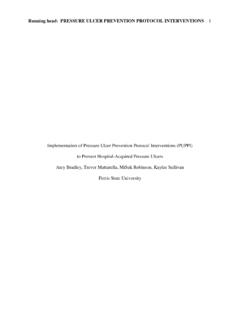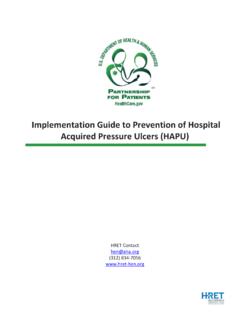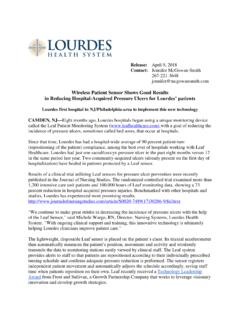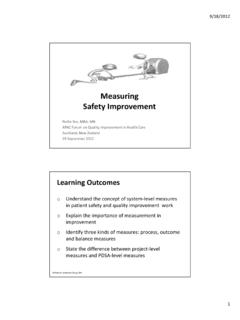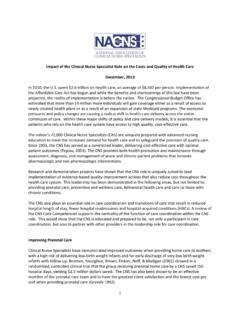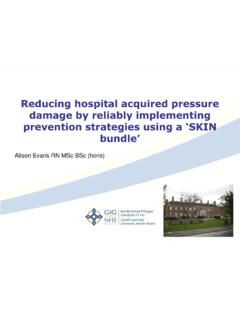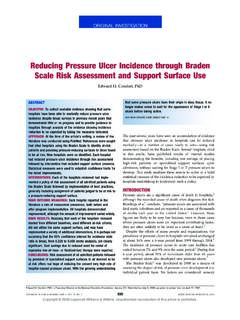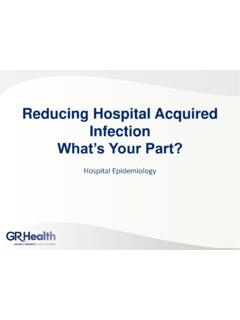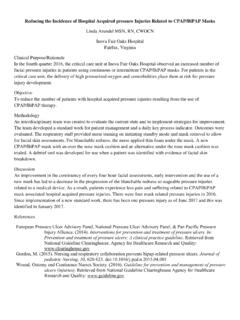Transcription of Pressure Ulcer Prevention: The Goal is Zero - IN.gov
1 Pressure Ulcer prevention : the goal is Zero Building Reliability in Pressure Ulcer prevention Kathy DuncanAugust 26, 2009 prevention Pressure UlcersThe Goal: Reduce the incidence of hospital - acquired Pressure ulcersFocus on getting to zero. reducing Pressure a skin and risk admission assessment for all skin and risk for all patients skin moisture nutrition and hydrationFor High Risk Patients:For All Patients:6. Minimize pressureDaily Skin and Risk Assessment Skin integrity can deteriorate in hours. Frequent assessment prevents minor problems from becoming major ulcers. Risk is predictable Key factors contributing to the development of Pressure Ulcer include age, immobility, incontinence, poor nutrition, sensory problems, circulation problems, device related Pressure , dehydration, and multiple co-morbidities Identification of at-risk patients help focus on implementation of prevention strategies Complexity and acuity of hospitalized patientsrequire daily reassessment of risk and skin assessmentManage Moisture Wet skin is more vulnerable to skin disruption and ulceration.
2 Dry skin is a risk factor as well. Care should be taken to minimize exposure of the skin to moisture due to incontinence, perspiration, or wound drainage. It may be necessary to use underpads made of materials that absorb moisture and present a quick-drying surface to the skin or use topical agents that act as moisture barriers and moisturize the skin. Optimize Nutrition and Hydration Patients with deficits may have muscle mass loss and weight loss making the bones more prominent and making it hard for patients to be mobile. There may be edema and reduced blood flow to the skin, causing ischemic damage , which contributes to skin breakdown. High protein diets may improve the healing of Pressure ulcers in malnourished nursing home patientsMinimize Pressure Redistribution of Pressure , especially over bony prominences, is of primary concern.
3 Turn/redistribute Pressure every 2 hours Patients with limited mobility are especially at risk for the development of Pressure ulcers. Continual Pressure , especially over bony prominences, increases risk. Pressure -relieving surfaces may Is it Possible?And just what is it?What is Reliability to You? Think of a process that you consider to be reliable What makes it reliable? How do you know it is reliable? What is Reliability? The measurable capability of an object to perform its intended function in the required time under specified conditions. (Handbook of Reliability Engineering, Igor Ushakov, editor) The probability of a product s performing without failure a specified function under given conditions for a specified period of time. (Quality Control Handbook, Joseph Juran, editor) The extent of failure-free operation over time.
4 (David Garvin)What Makes This So Hard? Improvement methods are highly dependent on vigilance and hard work The focus on outcomes (end product) tends to exaggerate the reliability of the steps along the way giving a false sense of security Lack of standardization creates variation in practice and results Design rarely accounts for human factorsIntent, Vigilance and Hard Work Designing basic failure prevention Common equipment, standard orders sheets Personal check lists Working harder next time Feedback of information on compliance Awareness and trainingDesign of Safe & Reliable Systems of Care: PreventDesign the system to prevent failure IdentifyDesign procedures and relationships to make failures visible when they do occur so that they may be intercepted before causing harm MitigateDesign procedures and build capabilities for mitigating the harm caused by failures when they are not detected and intercepted*Earl Weiner U of MiamiEspinosa/Nolan BMJM arch 2000 Prevent-Identify-Mitigate*Reliable Design Based on Human Factors Decision aids and reminders built into the system Desired action the default (based on evidence) Redundancy Scheduling Taking advantage of habits and patterns Standardization of processExamples of StrategiesBuilding Reliable ProcessesConduct a Pressure Ulcer Admission Risk Assessment.
5 Reassess Daily Use visual cues in admission documentation for completion of skin and risk assessment. Standardize risk assessment tool/checklist across the institution. Incorporate action steps linked to risk. Use multiple methods to visually identify patients at risk. Place stickers on chart, use visual cues on door and bed. Improve processes to ensure risk assessment isStandardization, decreasing reliance on memory, forcing functionconducted within four hours of admission and reassess daily. (redundancy)Manage MoistureStandardization, decreased reliance on memory, forcing function, less steps, visual reminder, taking advantage of habits and patterns (human factors) Allow staff to pilot potential supplies (underpads, cloths, barrier products) Keep kit of needed supplies at bedside for at-risk incontinent Brightly colored tub- Skin care products- Pads- WashclothsOptimize Nutrition/HydrationForcing Function, standardization, opt out rather than opt in Design process for automatic consult to dietician for at risk patients Wise use of supplements Mug at bedside Talk to the patient!
6 Minimize PressureForcing function, standardization, taking advantage of habits and patterns (human factors), reminders Use alerts and cues to remind staff to turn patient. Turn clock (Window, clock, door) Audio cues Turn Team Strategize high level bed assignments Seek Comfortable toolsHere s an Concepts; standardization, decreased reliance on memory, forcing function, less steps/complexity Share resources with community facilities- Skin Care Champions Rounds: Hourly or every 2 hours Make sure patient is clean and dry Offer water Turn/reposition patientHoly Spirit HospitalCamp Hill, Pennsylvania, United States of AmericaReducing hospital acquired Pressure UlcersPercent of Patients Receiving Pressure Ulcer Risk Admission Jan 07 Jul-07 Aug-07 Sep-07 Oct-07 Nov -07 Dec-07 Jan-08 Feb-08 Mar-0 8 Apr-08 May-08 Jun-08 Jul-08 Aug-08 Sep-08 Oct-08 Nov -08 Dec-08 Compliant RatePilot July-Sept 2007 Full Implementation.
7 Starting Nov 2007 Holy Spirit HospitalCamp Hill, Pennsylvania, United States of AmericaReducing hospital acquired Pressure UlcersPercent of Patients Receiving Daily Pressure Ulcer Risk Reassessment (NDNQI); Quarterly 1Q 073Q 074Q 071Q 082Q 083Q 084Q 08 Compliant RatePilot July-Sept 2007 Full Implementation: Starting Nov 2007 Goal=100%Holy Spirit HospitalCamp Hill, Pennsylvania, United States of AmericaReducing hospital acquired Pressure UlcersPercent of At-Risk Patients Receiving Full Pressure Ulcer Preventative Care (NDNQI); Quarterly 1Q 073Q 074Q 071Q 082Q 083Q 084Q 08 Compliant RatePilot July-Sept 2007 Full Implementation: Starting Nov 2007 Holy Spirit HospitalCamp Hill, Pennsylvania, United States of AmericaReducing hospital acquired Pressure UlcersPPressure Ulcer Incidence per 1000 Patient Jan 07 Jul-07 Aug-07 Sep-07 Oct-07 Nov -07 Dec-07 Jan-08 Feb-08 Mar-0 8 Apr-08 May-08 Jun-08 Jul-08 Aug-08 Sep-08 Oct-08 Nov -08 Dec-08 Incident RatePilot July-Sept 2007 Full Implementation: Starting Nov 2007 Hendricks Regional Health0246810121416 MAR 09 APR 09M AY 0 9 JUN 09 JUL 09 Sum of NosocomialPressure UlcersTOTALM aytotalincludes1 deep tissue injury










